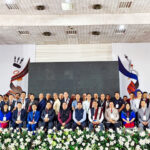The Central government on Monday informed the Supreme Court that it is considering setting up delimitation commissions for the delimitation exercise in the states of Arunachal Pradesh and Nagaland. Solicitor General Tushar Mehta conveyed this information to a bench comprising Chief Justice DY Chandrachud and Justices JB Pardiwala and Manoj Misra, as reported by PTI.
Additionally, Mehta stated that the process could be deferred in Manipur for what he referred to as “obvious reasons.”
In response, the Supreme Court bench asked Mehta to provide an update on this matter in two weeks.
This development occurred within the context of the Supreme Court hearing a plea that sought a directive for the initiation of a delimitation exercise in four northeastern states, which include Assam, Arunachal Pradesh, Manipur, and Nagaland. The court had issued notices to the Centre and other relevant parties regarding this plea on 25 July last year. The petition also sought directions for the formation of delimitation commissions in accordance with the provisions of the Delimitation Act, 2002. The petition argued that the delimitation exercise had not been conducted in Arunachal Pradesh, Manipur, and Nagaland for the past 51 years.
Revisiting Nagaland’s delimitation and controversial 2001 Census Data
The recent developments surrounding the delimitation exercise in Nagaland are deeply rooted in a complex historical context. The last delimitation exercise, conducted between 2002 and 2008, notably excluded Arunachal Pradesh, Assam, Manipur, and Nagaland. The exclusion was driven by concerns over the use of the 2001 Census data, which had raised apprehensions among various stakeholders.
On 8 February 2008, the government issued an order deferring delimitation in Nagaland. The rationale behind this decision was the “peculiar tribal configuration” of the state. Authorities believed that conducting delimitation based on the 2001 Census had the potential to disrupt tribal equilibrium, peace, and public order. They were also concerned about arousing sentiments among the hilly and tribal populations, fearing that the realignment of boundaries might lead to alienation and disturb the delicate existing tribal balance.
At that point in time, it was understood that delimitation had been deferred in Nagaland, along with Manipur, Assam, and Arunachal Pradesh in the North East and Jharkhand, until the relevant figures for the first census taken after 2026 have been published.
Fast forward to March 2020, a Delimitation Commission led by former Supreme Court judge Ranjana Prakash Desai was established under the BJP dominated government. Its mandate included redrawing constituencies in proportion to the population, aligning with the 2011 Census, in the Union Territory of Jammu and Kashmir, as per the J&K Reorganization Act 2019. However, for the northeastern states, including Nagaland, the Commission relied on the 2001 Census data, following the Delimitation Act of 2002.
On 28 February 2020, the Union government made a controversial decision to extend the delimitation exercise to the northeastern states, including Nagaland. Their justification rested on “significant improvements in the security situation and a reduction in insurgency incidents,” both of which were seen as conducive factors for the exercise.
However, this order has been red-flagged on multiple counts. Some took it to the Supreme Court, calling it “unconstitutional” and “illegal” while others objected to the use of the 2001 census.
The Chakhesang Public Organisation (CPO) took a leading role in opposing the decision. They filed a writ petition in the Supreme Court, challenging the Centre’s order to resume delimitation in Nagaland using 2001 Census figures. The CPO argued for utilizing 2011 Census data or the ongoing 2021 Census as a more suitable basis for the exercise. Meanwhile, the Lothas of Wokha led the campaign in favor of delimitation.
Vikas Kumar, co-author of “Numbers in India’s Periphery: The Political Economy of Government Statistics” (Cambridge University Press, 2020), in his article titled, “An Ill-timed Delimitation in Nagaland” writes that the Bharatiya Janata Party (BJP) has long focused on eastern districts, including Wokha and Dimapur, to build a base in Nagaland.
Interestingly, Kumar pointed out that in the Census 2001 report, Wokha reported the highest population growth rate, 95%, among the districts of Nagaland at that time. Longleng and Kiphire, which were later carved out of Tuensang as separate districts, also reported very high population growth rates in 2001. Notably, Kumar observed that these districts stand to benefit from delimitation using the 2001 Census data. Conversely, Phek, which is set to lose a constituency, has not been particularly favorable towards the BJP.
However, this delimitation will not change the number of seats in these states since there is a freeze until 2026 on the number of Lok Sabha and Assembly seats in any state. Instead, it will focus on redrawing seat boundaries and possibly reworking the number of reserved seats for SCs and STs.



